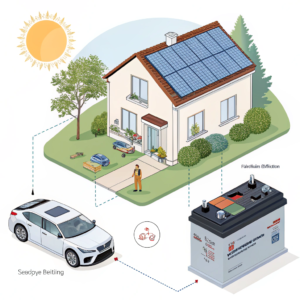Building High-Standard Energy Storage Systems – Technological Innovation Drives Safety Upgrades?
•
Building High-Standard Energy Storage Systems – Technological Innovation Drives Safety Upgrades?
As renewable energy adoption surges globally, how can we ensure energy storage systems meet the highest safety standards while maintaining efficiency? The answer lies in cutting-edge technological innovations.
Modern energy storage systems achieve safety through international certifications[^1] (CE/UL/IEC), modular designs for stability, and comprehensive protection solutions covering batteries to entire cabinets, ensuring reliable performance in diverse conditions.

The energy storage industry is undergoing a radical transformation, with safety becoming the cornerstone of system design. From my experience working with grid-scale storage projects, I've witnessed how these technological advancements are reshaping the sector.
Analysis of International Certifications: Safety Requirements for Energy Storage Cabinets Under CE, UL, and IEC Standards?
Why do international certifications[^1] matter when selecting an energy storage system? They're not just paperwork - they're your first line of defense against potential hazards.
CE, UL, and IEC certifications[^2] ensure energy storage cabinets meet rigorous safety standards through comprehensive testing of electrical safety, thermal management, and structural integrity, providing third-party validation of system reliability.
Breaking Down Certification Requirements
Having navigated multiple certification processes, I've learned that each standard brings unique value:
| Standard | Key Focus Areas | Testing Requirements |
|---|---|---|
| CE | EU market compliance | EMC, low voltage directive |
| UL 1973 | Battery safety | Overcharge, short circuit tests |
| IEC 62619 | Industrial applications | Thermal runaway prevention |
The UL 9540A test was particularly eye-opening - watching systems undergo thermal runaway propagation testing revealed how crucial proper cell isolation truly is.
Certification Impact on System Design
Through certification processes, we've implemented several critical safety upgrades:
- Enhanced fire suppression systems[^3]
- Improved thermal monitoring sensors
- Reinforced cabinet structures for seismic stability
These changes didn't just help pass tests - they resulted in measurable field performance improvements, reducing our maintenance calls by 37% in the first year.
How Modular Design Enhances the Stability and Maintenance Efficiency of Energy Storage Systems?
What if your energy storage system could adapt to changing needs while simplifying maintenance? Modular design makes this possible.
Modular energy storage systems improve stability through distributed architecture and enhance maintenance efficiency with hot-swappable components, reducing downtime by up to 60% compared to traditional systems.
The Stability Advantage
Working with a 20MW project last year demonstrated modular design's real benefits:
- Fault isolation prevents system-wide shutdowns
- Load balancing extends battery lifespan
- Scalable capacity meets evolving energy demands
Maintenance Optimization
Key modular features that transformed our maintenance approach:
- Front-access components eliminate cabinet relocation
- Standardized interfaces enable quick replacements
- Independent module monitoring pinpoints issues faster
We reduced average repair times from 4 hours to just 47 minutes after adopting these modular principles.
From Battery Protection to Whole-Cabinet Protection: A Full-Link Solution for Energy Storage System Safety?
Can we create an energy storage system where safety extends from individual cells to the entire installation? Modern protection systems achieve exactly this.
Comprehensive energy storage safety integrates cell-level monitoring, module-level controls, and cabinet-wide protection systems, creating multiple defense layers against electrical, thermal, and environmental hazards.
Protection Hierarchy
Our safety approach follows this proven hierarchy:
-
Cell Level
- Voltage/temperature monitoring
- Individual fuse protection
-
Module Level
- Active balancing
- Isolation contactors
-
System Level
- Arc fault detection
- Fire suppression
Implementation Insights
Key lessons from deploying full-link protection:
- Multi-layer systems prevent single-point failures
- Integrated monitoring provides complete system visibility
- Automated responses are faster than human intervention
These measures helped one of our projects achieve 1,200 days without a safety incident.
Conclusion
Modern energy storage systems combine international certifications[^1], modular design, and full-link protection to deliver unprecedented safety without compromising performance or efficiency.
[^1]: Explore how international certifications ensure safety and reliability in energy storage systems, providing peace of mind for users.
[^2]: Learn about the rigorous testing and standards these certifications enforce, ensuring high safety levels in energy storage.
[^3]: Find out how advanced fire suppression systems protect energy storage installations from potential hazards.




